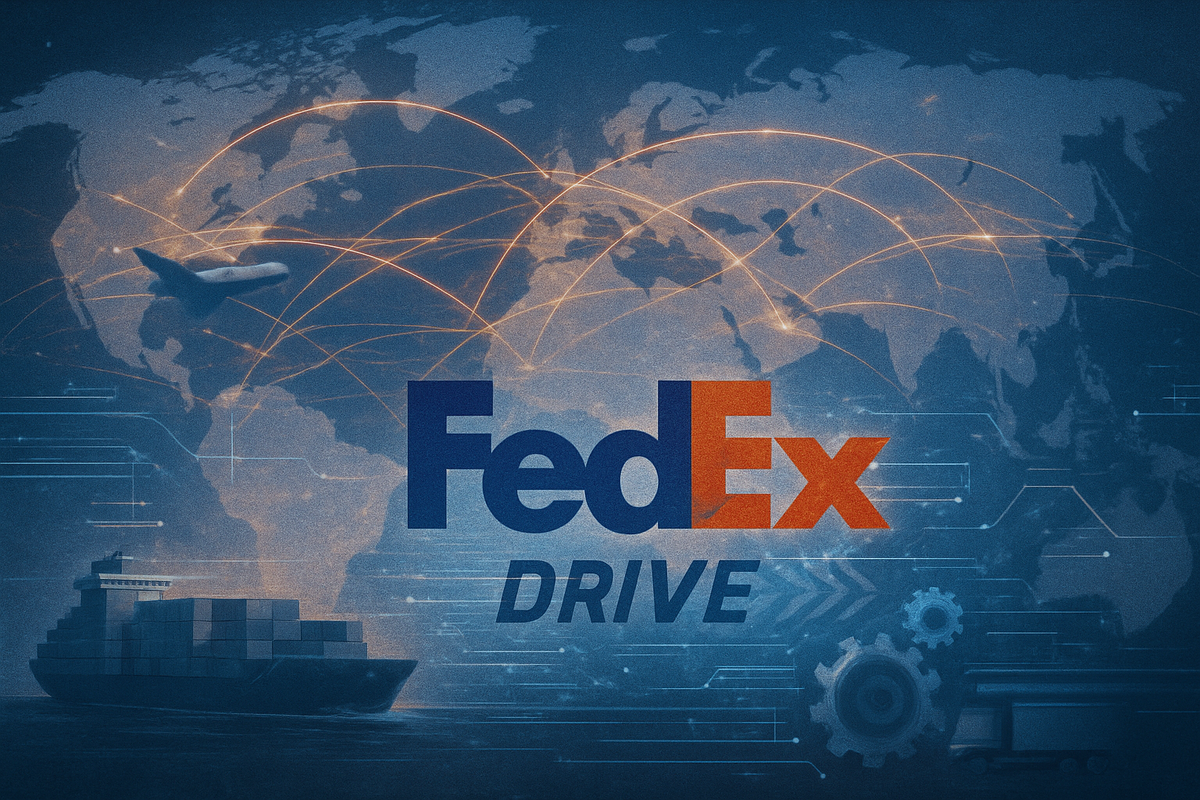
The global logistics and supply chain sector continues to face a period of unprecedented instability as of November 2025, with persistent macroeconomic headwinds, geopolitical tensions, and evolving consumer demands reshaping the industry. Amidst this complex landscape, shipping giant FedEx (NYSE: FDX) finds itself under significant downward pressure, grappling with reduced freight demand, a challenging shift in package mix, and the immense task of an internal operational overhaul. The company's recent performance reflects the broader industry's struggle to adapt to a "polycrisis" environment, where efficiency and resilience are paramount for survival and growth.
FedEx's Uphill Battle: Navigating a Volatile Market and Ambitious Transformation
FedEx's journey through fiscal years 2024 and 2025 has been a testament to both resilience and the profound challenges facing the logistics industry. While the company initially exceeded earnings per share (EPS) estimates in Fiscal Q3 and Q4 2024, largely due to aggressive cost-cutting under its "DRIVE" program, the underlying revenue environment remained challenging. Fiscal Q1 2025 (ending August 31, 2024) saw a significant downturn, with both adjusted EPS and revenue missing Wall Street projections, primarily due to weaker-than-expected U.S. domestic package demand and a struggling industrial economy. This prompted a downward revision of full-year fiscal 2025 guidance, sending ripples of concern through the market.
However, subsequent quarters, notably Fiscal Q2 and Q3 2025, demonstrated the mixed impact of FedEx's strategic responses. Despite continued revenue pressure, adjusted earnings saw significant boosts, largely attributed to the ongoing benefits of the DRIVE initiative, which targets $4 billion in structural cost reductions by 2025. The company’s Freight segment experienced contraction, but the Federal Express business showed some balance, with international demand partially offsetting domestic weakness. A critical development in December 2024 was the announcement of a planned full separation of FedEx Freight through a tax-free spin-off by June 2026, a move aimed at unlocking value and streamlining operations amidst the freight business's struggles.
Key players in this unfolding narrative include FedEx's executive leadership, particularly CEO Raj Subramaniam, who is spearheading the ambitious "DRIVE" program and network transformation. The company's vast network of employees, from pilots to package handlers, are also central stakeholders, directly impacted by operational changes and efficiency drives. Customers, ranging from large enterprises to individual e-commerce consumers, are experiencing the effects of evolving service offerings and pricing strategies. Initial market reactions to FedEx's performance have been volatile, with share prices reacting sharply to earnings reports and guidance revisions, reflecting investor concerns about the pace of recovery and the effectiveness of its transformation efforts in a persistently uncertain global economy.
Adding to the operational complexity, the expiration of FedEx's contract with the U.S. Postal Service in September 2024 necessitated a significant adaptation in U.S. freight volume strategies. Furthermore, the company has been actively managing its FedEx Freight operations, including the permanent closure of seven facilities to better align capacity with demand. Broader geopolitical tensions, particularly disruptions in key maritime routes like the Red Sea, have indirectly impacted air freight demand and costs, contributing to the overall "complexity" and "disruption" that FedEx and its peers must navigate. The grounding of MD-11 cargo planes has also been cited as a specific operational snag impacting capacity.
The Shifting Sands: Who Gains and Who Struggles in a Fractured Supply Chain
The current upheaval in global logistics creates a clear dichotomy between those poised to capitalize on the new realities and those likely to face sustained pressure. Among the potential winners are agile and technologically advanced logistics providers who have heavily invested in automation, AI, predictive analytics, and real-time visibility tools. These innovations enable better route optimization, inventory management, and overall resilience against disruptions. Companies that have diversified their supplier networks and embraced near-shoring or re-shoring strategies also stand to gain, reducing their vulnerability to geopolitical events and long-distance shipping costs. The Less-Than-Truckload (LTL) market, in particular, is set for a shake-up, with players like XPO Logistics (NYSE: XPO) and Old Dominion Freight Line (NASDAQ: ODFL) potentially seeing increased competition and new dynamics once FedEx Freight becomes an independent entity.
Conversely, the landscape is fraught with peril for those unable to adapt. Companies overly reliant on single, distant suppliers or those operating rigid "just-in-time" models without robust resilience measures are proving highly susceptible to the current volatility. Logistics providers struggling with macroeconomic headwinds, escalating operational costs (wages, fuel, purchased transportation), and a significant shift towards lower-yield services are experiencing considerable pressure on their operating margins. Retailers (NYSE: XRT) burdened by legacy systems, fragmented supply chains, and a lack of real-time inventory visibility are also at a distinct disadvantage, as consumer demands for rapid delivery continue to intensify.
E-commerce behemoths with robust in-house logistics capabilities, most notably Amazon (NASDAQ: AMZN), are emerging as significant winners. Amazon Logistics continues its aggressive expansion, processing 6.3 billion US delivery orders in 2024, a 6.78% increase from 2023, and now handles 28.2% of all packages shipped in the US. The company's massive investments in its own branded fleet, fulfillment infrastructure, and regionalized network have allowed it to cut costs while maintaining speed, posing an increasing competitive threat to traditional carriers like FedEx and United Parcel Service (NYSE: UPS), especially as Amazon expands its third-party shipping services. While UPS (NYSE: UPS) has shown resilience in some areas, with increased revenues in Q4 2024, it too faces macroeconomic uncertainty, leading to the withdrawal of its full-year profit forecast and plans to cut approximately 20,000 jobs in 2025 as part of a cost-cutting effort. DHL Group (FWB: DHL), meanwhile, maintains a stable outlook, investing heavily in digitalization and capacity management to sustain profitability despite revenue declines in some divisions.
A New Era of Supply Chain Resilience: Broader Trends and Regulatory Shifts
The challenges confronting FedEx are not isolated incidents but rather symptomatic of a fundamental shift in the global logistics paradigm. The broader industry is grappling with a "polycrisis" defined by persistent geopolitical instability, such as the ongoing conflicts impacting Red Sea shipping and the US-China trade tensions that continue to drive sourcing diversification. Economic volatility, marked by persistent inflation, fluctuating fuel costs, and rising interest rates, adds layers of complexity, making demand predictability a moving target. These factors, alongside chronic labor shortages, aging infrastructure, and the increasing frequency of climate-related disruptions, are compelling the entire sector to prioritize resilience, agility, and technological integration. The surge in e-commerce continues to fuel demand for rapid delivery, placing immense pressure on last-mile operations and air freight services, forcing companies to innovate or risk obsolescence.
The ripple effects of these trends and FedEx's strategic responses are profound. Competitors like United Parcel Service (NYSE: UPS) have already capitalized on shifts, notably by securing the lucrative US Postal Service (USPS) air cargo contract previously held by FedEx. This intensifies the competitive landscape, particularly in the domestic parcel market. E-commerce giants, especially Amazon (NASDAQ: AMZN) and Walmart (NYSE: WMT), are aggressively expanding their in-house logistics capabilities, further squeezing traditional carriers by internalizing their own shipping and even offering third-party services. This forces FedEx and UPS to not only compete with each other but also with their largest customers, necessitating continuous innovation in speed, cost-efficiency, and service offerings. Shippers and suppliers, in turn, face increased freight costs, greater complexity in navigating trade policies, and an urgent need to diversify their sourcing strategies and invest in robust supply chain visibility tools.
Regulatory and policy landscapes are also evolving rapidly in response to these global dynamics. Rising protectionism and geopolitical tensions are fueling an increase in tariffs and trade barriers, with potential new US tariffs on imports from key trading partners like Mexico and China threatening to force significant supply chain re-engineering and higher costs. Environmental regulations, such as the European Green Deal's stricter emissions standards for maritime transport and the EU's Carbon Border Adjustment Mechanism (CBAM), are pushing logistics providers towards greener technologies and sustainable practices. Furthermore, increased scrutiny on "de minimis" thresholds for duty-free imports and enhanced border security measures, particularly along the US-Mexico border, could introduce further delays and compliance burdens. These regulatory shifts underscore a global movement towards more accountable, sustainable, and secure supply chains.
Historically, the logistics industry has faced and adapted to numerous disruptions, offering valuable precedents. Geopolitical conflicts, from 9/11's impact on air cargo security to the current Russia-Ukraine war's effect on energy and commodity prices, have consistently forced rerouting and strategic re-evaluations. Natural disasters like the 2011 Tohoku earthquake and tsunami highlighted the fragility of concentrated manufacturing hubs, emphasizing the need for diversified networks. Economic downturns, such as the 2008-2009 Global Financial Crisis, led to drastic inventory reductions and a focus on demand-driven logistics. More recently, the US-China trade war served as a direct precursor to the current tariff-driven sourcing shifts, while the COVID-19 pandemic exposed unprecedented vulnerabilities, driving the current imperative for resilience. FedEx's ambitious DRIVE program and network transformation efforts reflect a concerted industry-wide attempt to learn from these past disruptions and build more adaptable, efficient, and future-proof operations.
The Road Ahead: Strategic Pivots and Emerging Opportunities in Logistics
The trajectory of global logistics and the fortunes of players like FedEx (NYSE: FDX) in the coming years will be shaped by a confluence of technological advancements, sustainability mandates, and a continued emphasis on resilience. In the short term (2025-2027), the industry will see an accelerated adoption of automation and AI, driven by the relentless growth of e-commerce, which is projected to hit $7.8 trillion globally by 2025. This necessitates innovation in last-mile delivery, micro-fulfillment, and advanced routing. For FedEx, its "DRIVE" program, targeting $2.2 billion in structural cost reductions for fiscal year 2025, and "Network 2.0," aiming for an additional $2 billion in savings by 2027, are critical short-term plays to boost efficiency and profitability. The planned spin-off of FedEx Freight by mid-2026 is another pivotal short-term move designed to allow the company to focus on its core parcel and logistics business and unlock shareholder value.
Looking further ahead (2028-2034), the logistics landscape will be defined by advanced digitalization, with AI, big data, IoT, and blockchain becoming foundational for transparency, efficiency, and predictive capabilities. Sustainable logistics will transition from an aspiration to a standard, driven by increasing environmental awareness and stringent regulations. FedEx has committed over $2 billion to achieve carbon-neutral global operations by 2040, including electrifying its entire pickup and delivery fleet and investing in sustainable energy for its facilities. Long-term, autonomous operations, including robots and vehicles, are expected to become increasingly common, accelerating processes and enhancing efficiency across the supply chain. FedEx's continued investment in automation at hubs and its "Tricolor Strategy" for air cargo demonstrate its commitment to these long-term trends.
The industry as a whole, and FedEx specifically, must embrace several strategic pivots. Hyper-automation and AI-driven operations will be essential for demand forecasting, route optimization, and predictive analytics to anticipate disruptions. A shift from purely "just-in-time" to "just-in-case" inventory strategies, coupled with diversified sourcing and localized hubs, will be crucial for building robust supply chain resilience. Sustainability must become a core strategic differentiator, involving continuous investment in green technologies and transparent reporting. For FedEx, successful execution of its large-scale transformations, including the integration of its Express and Ground networks and the Freight spin-off, carries inherent execution risks that could impact financial performance amidst intense competition from rivals like UPS (NYSE: UPS) and the rapidly expanding in-house logistics arms of Amazon (NASDAQ: AMZN) and Walmart (NYSE: WMT).
Navigating the New Normal: A Resilient Future for Global Logistics
The comprehensive analysis of global logistics and FedEx's (NYSE: FDX) current trajectory reveals an industry in the throes of a profound, multi-faceted transformation. The key takeaways from this period underscore the indispensable role of digitalization and AI in optimizing operations, the non-negotiable imperative of sustainability in business practices, and the critical shift towards building truly resilient and adaptable supply chains. E-commerce continues its relentless expansion, driving the demand for ever-faster and more transparent delivery, while FedEx's aggressive "DRIVE" program and "One FedEx" strategy are demonstrably delivering results, achieving significant cost reductions and fostering a more integrated network.
Moving forward, the market will remain characterized by persistent volatility, shaped by geopolitical conflicts, fluctuating demand, and capacity constraints. However, this environment also accelerates technological adoption, pushing companies towards hyper-efficient and intelligent networks. The enduring challenges of labor shortages and infrastructure gaps will continue to exert pressure, necessitating sustained investment and innovative solutions. The lasting impact of this era will be a paradigm shift towards logistics networks that are not only efficient but also predictive, self-optimizing, deeply embedded with sustainability, and ultimately, customer-centric.
For investors, the coming months will be crucial for monitoring FedEx's continued execution of its DRIVE program and its ability to achieve further structural cost reductions in fiscal 2026. Key financial indicators, including revenue growth rates and adjusted earnings per share guidance, particularly after accounting for business optimization costs, will be paramount. Investors should also closely watch FedEx's capital allocation strategies, including its dividend increases and share repurchase programs, as well as broader macroeconomic trends, geopolitical developments, and the competitive landscape, especially the ongoing technological race and the expansion of in-house logistics by e-commerce giants. The success of the logistics sector, and FedEx within it, hinges on continuous adaptation, technological integration, and a proactive approach to managing complex global risks in this new, resilient future.
This content is intended for informational purposes only and is not financial advice






